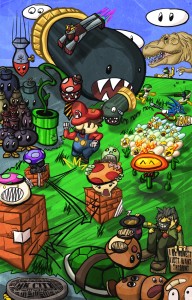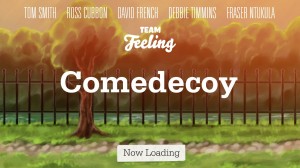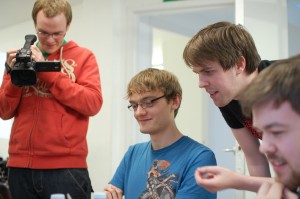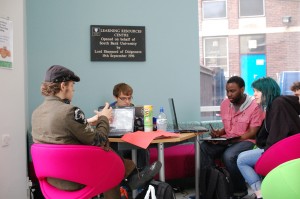MolyJam – The Aftermath
- Updated: 3rd Apr, 2012
 Now that the MolyJam is all over, it’s time to take a breather and figure out what the hell we made. I described the event and posted a few impressions from the first day on Friday night. Here’s what happened over the weekend.
Now that the MolyJam is all over, it’s time to take a breather and figure out what the hell we made. I described the event and posted a few impressions from the first day on Friday night. Here’s what happened over the weekend.
Somehow I got swept up in a team of three artists and two writers. Fraser Ntukula is an artist and animator. David French draws and paints amazing cartoons, one of which you can see here. Ross Cubbon did the UI and I didn’t talk to him long enough to get a nice one-sentence summary. Tom Smith writes and podcasts at OhNoVideoGames and had cobbled together four previous games in GameMaker. And I write for The Average Gamer, obviously. The five of us had never met before Friday and here we were, making a game together.
As you might expect, the lack of programmers limited our ability to implement the original vision. Instead, we focused on the principles of joke telling and emotion reading. Verbal joke-telling became a series of conversation options. Pacing became a time limitation. Dynamic facial expressions became a series of emotional states.
 No longer do you watch guards get visibly bored of your crappy joke-telling skills and change your style accordingly. Instead, you have a short conversation to figure out what type of joke each guard likes and then pick from a pre-approved list.
No longer do you watch guards get visibly bored of your crappy joke-telling skills and change your style accordingly. Instead, you have a short conversation to figure out what type of joke each guard likes and then pick from a pre-approved list.
As the writer who doesn’t know GameMaker, it fell to me to write the conversations. Bahahahaaaa! I have never written a conversation in my life, let alone an entire dialogue tree of hints, jokes and emotional states. Making it coherent? More like a happy accident than a job well done. I wrote ten different lead-ins to a “that’s what SHE said” joke. In a typical play-through you’ll see two of these at most.
Lessons learned:
I used to be a project manager in NHS software development. I’ve never worked in this sort of environment. It felt similar to development in the office but at same time, so much more productive.
Decisions weren’t subject to endless debate – we didn’t have time. We had to completely trust one another to deliver what was required for the team or ask for help if we had too much on our plate.
What went right?
- We finished the game, hooray! It’s a fully playable alpha build.
- It looks beautiful.
- Each character is distinct.
- The game fits the original inspirational tweet.
- We settled into complementary team roles very quickly and delivered what was required.
- We weren’t afraid to cut features that we couldn’t achieve.
- We successfully fended off inquisitive journalists before Tom has a nervous breakdown in the final hour of programming.
- We stepped up for one another when things weren’t going according to plan.
What went wrong?
- The game is balls.
Seriously, it’s not fun to play. We discussed and cut so many features that we completely destroyed the pacing of the game. To get enough art to cover all the facial expressions for each guard, we dropped the number of emotional states from seven down to five and eventually to three plus a win state (i.e. the guard rolling on the floor laughing). Combine that with the brevity of conversations and you have very little time to work out what each guard likes.
We designed and built a feature to ease the blow of failed conversations. Once you realised that you made the guard angry, a panic button would be enabled for a few seconds. If pressed, it would scroll through an alternative list of jokes and blurt one out very loudly, with a small chance of success. Due to a particularly game-destroying bug, that feature was cut in the final hour of development.
Basically, Comedecoy is filled with insta-fail options, a dramatic fail screen that – thanks to a programming bug – doesn’t tell you what you did wrong and a single path to success. But it looks pretty.
You can play it now if you like. Download Comedecoy from the MolyJam site. Be prepared to fail.
How do we do better next time?
- Planning a dialogue tree in a notepad is a terrible idea. Use a spreadsheet. Better yet, use post-its and map paths out on rolls of paper. THEN start writing the words. It’s very easy to make these things web out into dozens of alternatives that the majority of players will never see.
- Plan the structure of the dialogue tree BEFORE writing. Thanks to my changing the structure between conversations and not telling Tom beforehand, pressing certain keys will often cause the game to crash.
- Collaborate with the team. Working from home on Saturday due to the lack of available machines, I wrote an opening gambit of “Nice set of guns you got there” and a response for every character. Did I remember to tell the character artist that Guards B and D needed visible guns and A needed a good strong set of biceps? Nooooo. Everything became much easier on Sunday when I could just lean over and go “Hey, give the robot a scalpel, yeah? He wants to be a surgeon.”
- Use placeholder art that represents EVERYTHING. Very early on we had placeholder art for the programmer to test what he was calling, but none of it represented anything other than “a picture goes here”. Had we used rough expressions to indicate emotional state, we probably would have realised early that the emotions changed far too abruptly and adjusted the dialogue structure to compensate.
- Make sure the artists are talking to each other. We divvied up the art into three natural categories – UI, backgrounds and characters. Unfortunately, both Fraser (background) and David (characters) thought they had the same section of screen to use for details.
As a result, the final pay-off and joke from the game’s design was almost perfectly obscured by the burning corpse of our robot guard. D’oh.
Ever made a game or participated in a game jam? What other advice would you give someone doing this?




3 Comments